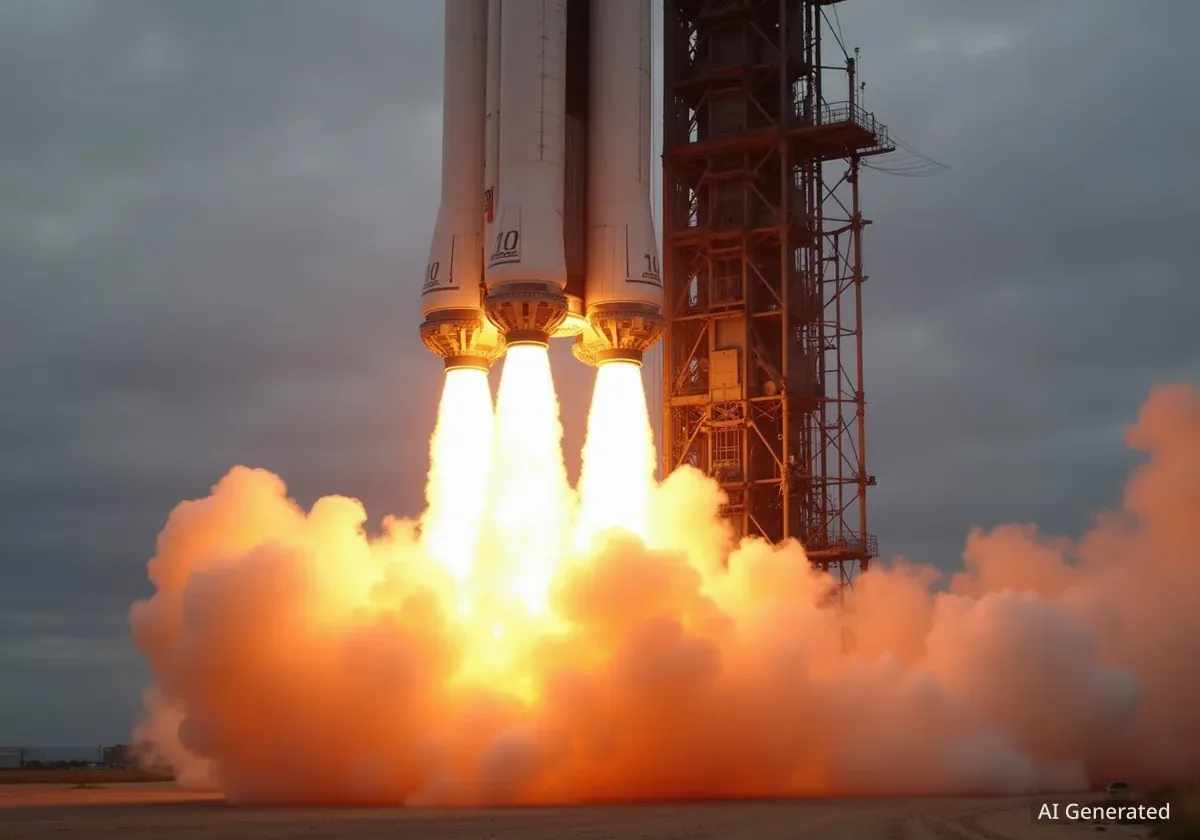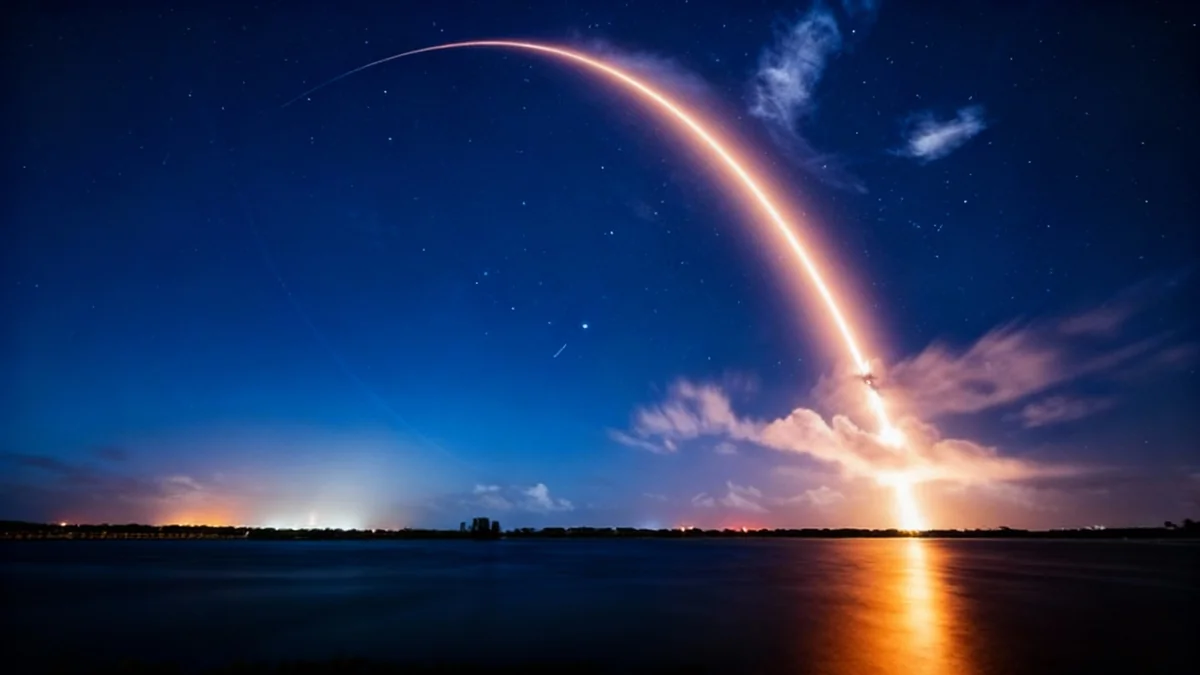SpaceX has successfully completed a critical ground test of its Starship upper stage, firing all six of its Raptor engines simultaneously. The test, known as a static fire, is a major step in the preparations for the eleventh test flight of the world's most powerful rocket system.
The event took place at the company's Starbase facility in South Texas. During the test, the vehicle remained secured to the launch mount while its engines were briefly ignited. This procedure verifies that the propulsion systems are ready for an actual launch.
Key Takeaways
- SpaceX performed a static fire test on its latest Starship upper stage vehicle designated for Flight 11.
- The test involved firing all six Raptor engines while the vehicle was anchored at the Starbase launch site.
- This milestone follows a similar successful test of the Super Heavy booster intended for the same mission.
- Flight 11 will be the final mission for the current "Version 2" design of the Starship vehicle.
Details of the Static Fire Test
SpaceX confirmed the completion of the static fire test via a post on the social media platform X on Monday, September 22. The announcement included an image showing the six Raptor engines firing, demonstrating a key performance milestone before the vehicle is cleared for flight.
This test is a standard but essential part of SpaceX's pre-launch checklist. It allows engineers to collect valuable data on engine performance, vehicle integrity, and ground systems without the vehicle leaving the launch pad. Both the Starship upper stage and its Super Heavy booster must undergo these tests before they are integrated for a full-stack launch.
What is a Static Fire?
A static fire is a type of ground test where a rocket's engines are ignited for a short duration, but the vehicle itself is held down and does not lift off. This allows teams to test the full propulsion system under flight-like conditions in a controlled environment, ensuring all components work as expected before committing to a launch.
With the successful test of the upper stage, both major components for Flight 11 have now completed their primary engine checks. The Super Heavy booster, which will propel the Starship off the launch pad, had previously undergone its own static fire test, making the combined vehicle nearly ready for its next mission.
Progress Following a Successful Flight 10
The upcoming Flight 11 builds on the significant success of the tenth test flight, which occurred on August 26. That mission marked a major achievement for the Starship program, as it was the first time both the Super Heavy booster and the Starship upper stage completed their flight profiles and achieved controlled splashdowns in their designated landing zones.
During Flight 10, the Super Heavy booster successfully landed in the Gulf of Mexico, while the Starship spacecraft traveled halfway around the world before making a controlled entry and splashdown in the Indian Ocean. The mission also demonstrated a new capability by deploying eight dummy payloads into space, a first for the program.
Starship Flight History
The Starship program has followed an iterative development process. While Flight 10 was a success, the three preceding test flights experienced premature losses of the upper stage vehicle. Another prototype was also lost during a ground test in June, highlighting the challenging nature of developing a fully reusable launch system of this scale.
The success of Flight 10 was seen as a crucial rebound, demonstrating that SpaceX had resolved many of the issues that affected earlier missions. The data gathered from that flight has been instrumental in preparing for Flight 11, which aims to further refine the vehicle's performance and reliability.
The Grand Vision for Starship
SpaceX is developing Starship with the ambitious goal of creating a fully and rapidly reusable transportation system capable of carrying humans and cargo to Earth orbit, the Moon, Mars, and beyond. When fully stacked, Starship stands as the tallest and most powerful rocket ever built.
The system consists of two distinct elements:
- Super Heavy: The first-stage booster, powered by over 30 Raptor engines, designed to return to the launch site for rapid reuse.
- Starship (Ship): The upper-stage spacecraft, which also functions as an in-space vehicle for crew and cargo, powered by six Raptor engines.
According to SpaceX founder and CEO Elon Musk, the reusability of both stages is the key to dramatically lowering the cost of access to space. This reduction in cost is considered essential for enabling large-scale activities like establishing a self-sustaining city on Mars.
"Starship is designed to help humanity settle Mars and embark on other exploration tasks," a SpaceX mission statement has previously noted, underscoring the long-term vision behind the vehicle's development.
Looking Ahead to Starship Version 3
While preparations for Flight 11 are nearing completion, SpaceX is already looking toward the future. The eleventh flight is scheduled to be the final mission for the current iteration of the vehicle, known as "Version 2."
Following this flight, the company plans to transition to Starship Version 3. This next-generation design is expected to be even larger and more capable, specifically optimized for carrying the significant amounts of cargo and personnel required for missions to Mars.
Elon Musk has provided a tentative timeline for these future missions. He has suggested that if the test campaign for Version 3 proceeds as planned, the first uncrewed Starship cargo missions could be launched toward the Red Planet as early as late 2026. This timeline is aggressive and depends on the successful and rapid validation of the new vehicle design.
The development of Starship continues at a rapid pace at the Starbase facility, with multiple prototypes in various stages of construction. Each test flight, whether successful or not, provides critical data that feeds back into the design and manufacturing process, pushing the program closer to its ultimate goal of making humanity a multi-planetary species.





